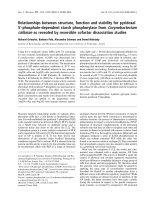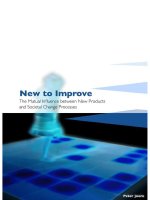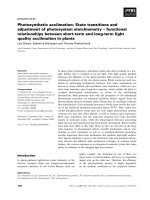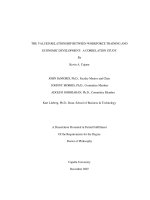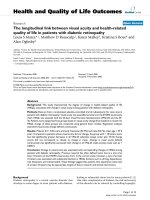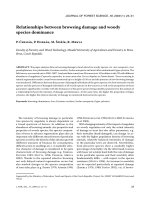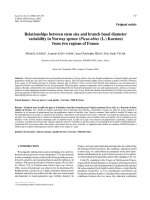AIEA, 2019 - Navigating the Complex Relationships between Pathway Providers and University Stakeholders (Costello, Harris-Sealey, Bakar)
Bạn đang xem bản rút gọn của tài liệu. Xem và tải ngay bản đầy đủ của tài liệu tại đây (808.91 KB, 11 trang )
1/22/2019
Navigating the Complex Relationships
between Pathway Providers and
University Stakeholders
Kari Costello, DBA - DePaul University
Nicole J. Harris-Sealey, PhD - Salem State University
Senem S. Bakar - American University
Session Overview
• Introduction & Goals for Session
• Historical Context for Third-Party Providers of Pathway
Programs
• Institutional Cases
• DePaul University/EC Higher Ed, 0 years (Kari)
• American University/Shorelight, 3 years (Senem)
• George Mason University/INTO University Partnerships, 5 years (Nicole)
• Breakout Discussion Groups
• Group Reports
• Conclusions and Follow Up
1
1/22/2019
Session Purpose and Goals
• Three perspectives at different stages of progression with differing
lenses
• Insights and advise for institutions considering pathway programs
• Explore your institution’s opportunities and challenges with respect to
pathway programs
Administrative
Operations
Immigration &
Student
Services
Academic
Affairs &
Enrollment
Management
Context for Third-Party Providers of
Pathway Programs
• Pathway programs are postsecondary programs of study that
combine credit-bearing coursework with developmental
English as a second language (ESL) coursework to prepare a
student who is unable to meet the English proficiency
standards for admission (SEVP 2016).
• Currently eight (8) major Third Party companies active in US
market (Choudaha, 2017).
• Top three reasons for engaging in partnering:
• Recruitment access/increase or diversify enrollment
• Lack of in-house expertise
• Lack of investment capital/institutional infrastructure
2
1/22/2019
Context for Third-Party Providers of Pathway
Programs
Significant expansion of sector participation over
the past decade:
US‐based Institutions engaged in Pathway
Partnerships with 3rd Party Providers
2008
2016
2
45
CONCLUSION: “Successful partnerships
will require transparency and inclusive
engagement that ultimately support the
students and the mission of the
institution.” (p. 43).
Choudaha, R. (2017). Landscape of ThirdParty Pathway Partnerships in the United
States. NAFSA: Washington, DC.
• Founded in 1898
• Largest catholic university in US, 14th largest
private university
• 1800 international students, roughly 7%
Case 1:
DePaul
University
• Ranked #119, US News & World Report, 2019
• Primary mission is teaching and service
3
1/22/2019
The Pathway Partnership Decision
• Moderate success with USPP program
• New university leadership and direction
• Decision criteria
• Cultural fit for DePaul
• Full academic control
• Stakeholder involvement, particularly our IEP
• Timeframe
• From RFP to partner selection to final signature = 8 months
• I-17 approval = about 8 months
DePaul Pathway Structure
• Academics
• DPU designed, owns, and delivers all curricula
• Our IEP is a critical component for ESL and Academic courses
• Graduate Programs in CDM and BUS; UG Programs in all areas
• Staffing
• Pathway Program Director on-site (EC)
• DPU Admissions, ISS, Faculty, and other staff as needed
• Governance
• Weekly meetings with University and EC liaisons
• Monthly to Quarterly Advisory Committee (3 DPU and 3 partner
representatives)
4
1/22/2019
DePaul University and EC Higher
Education
• What worked?
• Open communication, brutal honesty, persistence and
occasionally bending on ‘non-negotiables’
• What didn’t?
• I-17 challenges, anticipating staffing changes, coordinating joint
marketing and recruitment efforts
• Words of Wisdom
• Think carefully through every point in your contract
• Be strategic about university stakeholder buy-in
• Plan as much as you can in advance of entering the agreement,
you can always tweak as things evolve
• Founded in 1893, private, Co-ed, liberal arts
curriculum
Case 2:
American
University
• Around 2,000 international student from over 130
countries
• 8 schools with over 155 degree programs
• #69 best national university (2017 US News &
Report)
• Top producer of Fulbright scholars (US News and
Report 2013)
• #4 most politically active students (2014 Princeton
Review Best Colleges)
• Princeton Review Green Rating Honor Roll (2015)
5
1/22/2019
Partnership Decision
Timeline and Model
• Contract signed in October 2015
• First undergraduate level soft launch in Fall 2016
• First graduate level in spring 2017
• Evolved from existing AU bridge program on I-17*
• Infrastructure by Shorelight, Academics by AU
6
1/22/2019
Highlights for Consideration
• DHS Permission to issue pathway I-20
• Key players and clarified expectations
• Constraints: time, technology, physical & human resources
• Marketing material & communication management
• The Curriculum, Policies and Protocols
Final Words...
7
1/22/2019
Case 3:
George Mason
University
•
Largest, Public, R1 institution located
close to Washington, DC Metro area
•
Most diverse college in Virginia
•
Founded in 1972
•
Three campuses (distributed model)
& several sites, including Songdo,
Korea
•
Enrollments upwards of 36,000
•
International enrollment averaging
7%
Timeline & Model
• English Language Institute (ELI) (19822014)
• Intensive English Program
• Outreach services to the campus
community
• Center for International Student Access
(2010-2014)
• ACCESS Program (Undergrad)
• BRIDGE Program (Grad)
• CISA and ELI actively participate in
academic planning for Mason Korea
(2012-2013)
• Merger of CISA and English Language
Institute (ELI) forming INTO George Mason
University Joint Venture (Fall 2014 Present)
Joint Venture Model
• Shared inputs, risks, rewards
• Faculty are university
employees; staff are Joint
Venture employees
• Shared decision-making model
• University enrollment goals vs
market desires
8
1/22/2019
Engagement with University Stakeholders
Timeline
Relationship Navigation
Before Transition
(Decision-Making)
•
During Transition
•
•
•
•
•
•
After Transition
•
•
•
Significant source organizational anxiety and stress
• University leadership focused on financial solvency needs/mission; IEP faculty
focused on traditional values of student quality and academic freedom, jobs
Destabilization of organizational staffing
Large scale workgroups over a short period of time to set up and establish
structural/curricular/admissions changes
Townhalls with university community to discuss decision and address concerns
Tasks of temporary team placed to launch center absorbed by existing employees
Hiring of new faculty and staff to add to returning faculty ranks
Discontinuities of the university exposed (Winkle, 2011)
Returning faculty and staff sharing historical information and aiding problem-solving—
new faculty and staff assimilating old information and new mandates for sensemaking
Institutional leadership transitions offer potential destabilization of forward momentum
Continuous negotiations and adjustments to respond to market demands for
competitiveness
Matters for Consideration
Academic Affairs
• Decentralized Admissions
• Shared governance over
curriculum and admissions
• Academic Integrity
• Stretching FERPA policies
• Speed of changes and assessment
results
• Policy development
• International market program
interests/desires vs program
appetite
Enrollment
management/retention
• Additional tuition discounting
• Meeting additional
needs/expectations of sponsoring
agencies
• Development of “custom
programs”
• Impact of “success” on
Infrastructure (e.g., writing center,
loss of IEP as a resource for
generalized ESL support)
9
1/22/2019
Advice and Lessons Learned
Do be open and transparent. Communicate issues that lead to the speed/urgency
of the decision.
Do be willing to take a bit more time to set up the partnership if that means having
more buy-in from institutional stakeholders.
? How are faculty who teach English language courses valued and integrated in your institutional
structure?
Do recognize that setting up the partnership is only the beginning and that it
requires significant maintenance--plan and identify leadership to oversee this.
? How will the university handle the partner’s inevitable leadership transitions?
Do ask schools beyond those recommended; “negative” feedback can be helpful
to avoid pitfalls.
Do examine institutional culture around collaboration, working with international
students, non-traditional approaches to expedite governance procedures.
Do start immediately with strategically preparing your faculty/colleges for teaching
increased numbers of international students through training and incentivization.
Discussion Questions
• Share your institution’s involvement with third party pathway providers. If
you have a pathway partner, what is working well and what is not?
• Which university stakeholders should be involved and at what stages? For
example, who should be involved in partner selection, negotiating terms
of agreement, determining level of integration/engagement on campus,
etc.
• How do you manage misunderstandings between the partner and
university stakeholders?
• What strategies have you used to build working relationships between
university stakeholders and pathway partners?
• What has been the most helpful advice you have heard today that you
can use on your campus?
10
1/22/2019
Bibliography
• Choudaha, R. (2017). Landscape of Third-Party Pathway
Partnerships in the United States. NAFSA: Washington, DC.
• Sealey, N. J. and Robb, D. (2011, November). Expanding ACCESS to
International Students. Presentation at the American Association of
Collegiate Registrars and Admissions Officers - 21st Annual Strategic
Enrollment Management Conference: The origin and future of SEM,
San Diego, CA.
• Winkle, C., Hardwick, R., Hoffman, T., McCafferty, J., Sealey, N. J., &
Stevens, S. (2013, March 23). Creating our own pathways:
Institutional alternatives to corporate partnership models.
Colloquium at TESOL’s 47th Annual Convention and Exhibit, Dallas,
TX.
• Winkle, C. 2011. “A Narrative Inquiry into Corporate Unknowns:
Faculty Experiences Concerning Privatized-Partnership Matriculation
Pathway Programs.” Dissertation, Barry University.
11
